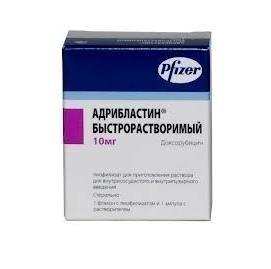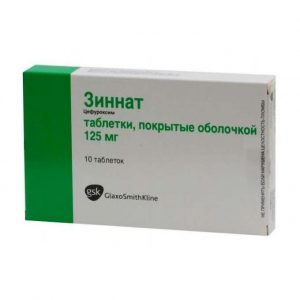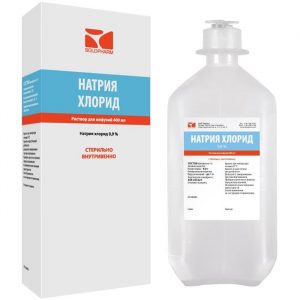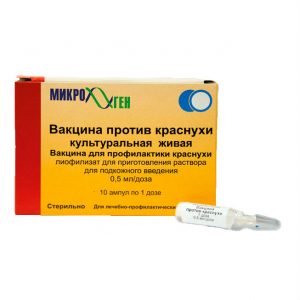Description
Latin name
ADRIBLASTIN
Packaging
In a 10 mg vial, complete with solvent. In a cardboard box 1 set.
Pharmacological action
Pharmacodynamics
Doxorubicin is a cytotoxic anthracycline antibiotic isolated from Streptomyces peucetius var. caesius.
The cytotoxic effect of doxorubicin on malignant cells and its toxic effects on various organs is probably due to intercalation of nucleotide bases and the ability of doxorubicin to bind to cell membrane lipids. Intercalation inhibits nucleotide replication and the activity of DNA and RNA polymerases. The interaction of doxorubicin with topoisomerase II with the formation of DNA-cleavable complexes is considered an important mechanism of the cytotoxic effect of doxorubicin.
Pharmacokinetics
Distribution of
Initial T1 / 2 is about 5 minutes and indicates a rapid distribution of doxorubicin in tissues of the terminal T1 / 2 – 20 – 48 hours. The connection of doxorubicin and its main metabolite, doxorubicinol, with plasma proteins is 74-76% and not depends on the concentration of doxorubicin in plasma (up to 1.1 μg / ml). Doxorubicin does not cross the blood-brain barrier.
Metabolism
Enzymatic reduction at position 7 and the breakdown of daunosamine sugar leads to the formation of aglycones, which is also accompanied by the formation of free radicals. The latter may cause the cardiotoxic effects of doxorubicin. T1 / 2 of doxorubicinol is similar to that of doxorubicin.
The ratio between the AUC of doxorubicinol and the AUC of doxorubicin compared with doxorubicin is 0.4-0.6.
Excretion of
The clearance of doxorubicin is carried out mainly through metabolism and excretion with bile. Approximately 40% of the dose is excreted in the bile within 5 days. Only 5-12% of doxorubicin and its metabolites are found in urine over the same period of time. Within 7 days, less than 3% of the dose is excreted in the form of doxorubicinol with urine.
Systemic clearance of doxorubicin is significantly reduced in obese women whose body weight is more than 130% of the optimal.
Pharmacokinetics in special groups
Children
Doxorubicin clearance in children older than 2 years exceeds that in adults. The clearance in children under 2 years old approaches the values of clearance in adults.
Elderly
Dose adjustment based on age is not required.
Sex
The average clearance of doxorubicin in men is significantly higher than in women. However, terminal T1 / 2 of doxorubicin in men is longer than in women (54 and 35 hours, respectively).
Race
The effect of race on the pharmacokinetics of doxorubicin has not been studied.
Impaired liver function
In patients with impaired liver function, the clearance of doxorubicin and doxorubicinol is reduced.
Impaired renal function
The effect of renal function on the pharmacokinetics of doxorubicin has not been studied.
Indications
Acute lymphoblastic leukemia
acute myeloblastic leukemia
chronic leukemias
Hodgkin’s disease and non-Hodgkin’s lymphoma
multiple myeloma
osteosarcoma
Ewing’s sarcoma Hodzhki
soft tissue sarcoma
neuroblastoma
rhabdomyosarcoma
Wilms tumor
breast cancer
endometrial cancer
cancer ovarian
germ cell tumors
prostate cancer
transitional cell bladder cancer
lung cancer
stomach cancer
primary hepatocellular th
cancer head and neck cancer
thyroid cancer.
Use during pregnancy and lactation
Contraindicated during pregnancy and lactation.
Composition of
1 vial contains:
Active substances: doxorubicin hydrochloride 10 mg.
Solvent: water d / i – 5 ml.
Dosage and administration of
Intravenous, intravesical or intraarterial.
Adriblastin ® instant can be used both in monotherapy and in combination with other anticancer drugs, and therefore, when choosing doses and the regimen of the drug should be guided by the data of special literature. A reconstituted solution of the drug is recommended to be used immediately after preparation.
Intravenous administration of
As a monotherapy, the recommended standard dose per cycle for adults is 60-90 mg / m2. The total dose per cycle (every 3-4 weeks) can be administered both simultaneously and divided into several injections, for 3 consecutive days or on the first and eighth days of the cycle. A weekly regimen of administration of the drug at a dose of 10-20 mg / m2 is also used. When using doxorubicin in combination with other antitumor drugs with similar toxicity, the recommended dose per cycle is 30-60 mg / m2.
Repeated administration of the drug is possible only with the disappearance of all signs of toxicity (especially gastrointestinal and hematological).
To reduce the risk of thrombosis and extravasation, Adriblastin ® is recommended to be administered rapidly via the tube system for intravenous infusion, during the infusion of 0.9% sodium chloride solution or 5% dextrose solution. The duration of the infusion should be from 3 to 10 minutes.
The total dose of doxorubicin should not exceed 550 mg / m2.
For patients who have previously received radiation therapy for the mediastinal / pericardial region or have taken other cardiotoxic drugs, if it is necessary to increase the total dose of doxorubicin more than 450 mg / m2, the drug should be administered under strict monitoring of heart function.
Failure of the liver:
if the serum bilirubin level is 1.2-3 mg / dl, the administered dose of the drug should be reduced by 50% of the recommended
if the serum bilirubin level in the blood exceeds 3 mg / dl, then the dose should be reduced by 75 % of recommended.
Other special patient groups: lower doses or longer cycle intervals are recommended for patients who have previously received intensive chemotherapy, children, elderly patients, and obese patients (if body weight is more than 130% of optimal, a decrease in systemic clearance of the drug is noted) as well as patients with tumor bone marrow infiltration.
Introduction to the bladder
Introduction to the bladder is used to treat superficial bladder tumors, as well as prophylaxis to reduce the likelihood of relapse after transurethral resection. The introduction into the bladder is not suitable for the treatment of invasive tumors with penetration into the muscle wall of the bladder.
The recommended dose for installation is 30-50 mg in 25-50 ml of 0.9% sodium chloride solution. In case of development of local toxicity (chemical cystitis), the dose should be dissolved in 50-100 ml of 0.9% sodium chloride solution. Instillations can be carried out with an interval from 1 week to 1 month.
Instillation should be carried out using a catheter, while the drug should remain in the bladder for 1-2 hours. To ensure uniform effect of the drug on the mucous membrane of the bladder, the patient should turn from side to side during instillation. In order to avoid excessive dilution of the drug with urine, Patients should be warned that they should refrain from taking fluid for 12 hours before instillation. At the end of the instillation, the patient should empty the bladder.
Intraarterial administration of
To patients with hepatocellular cancer to provide intensive local effects while reducing the overall toxic effect, the drug can be administered intraarterially into the main hepatic artery at a dose of 30-150 mg / m2 with an interval of 3 weeks to 3 months. Higher doses should be used only in cases of simultaneous extracorporeal excretion of the drug. Lower doses are suitable for the administration of doxorubicin in combination with iodinated oil. Since this method is potentially dangerous and can lead to widespread tissue necrosis, intraarterial administration should be carried out only by doctors who are fluent in this technique.
Side effects
From the hemopoietic system: leukopenia, neutropenia, anemia, thrombocytopenia.
From the cardiovascular system: sinus tachycardia, tachyarrhythmias, atrioventricular block, bundle branch block, congestive heart failure, hemorrhage, hot flashes, phlebitis, thrombophlebitis, thromboembolism, shock, changes in ECG, asymptomatic decrease, asymptomatic.
There is a risk of cardiotoxicity during anthracycline therapy – early (i.e., acute) or late (delayed).
The manifestation of early cardiotoxicity of doxorubicin is mainly sinus tachycardia and / or ECG abnormalities (nonspecific ST-T wave changes). Tachyarrhythmias (including ventricular extrasystole and ventricular tachycardia), bradycardia, atrioventricular block and bundle branch block may also occur. These effects are not always a predictive factor in the development of subsequently delayed cardiotoxicity, are rarely clinically significant and usually do not require discontinuation of drug therapy.
Late cardiotoxicity usually develops in the later stages of the course of therapy or within 2-3 months after its discontinuation, however, more delayed side effects may develop (several months or even years after the end of therapy). Late cardiotoxicity is manifested by a decrease in the ejection fraction of the left ventricle and / or symptoms of congestive heart failure, such as shortness of breath, pulmonary edema, edema, cardiomegaly and hepatomegaly, oliguria, ascites, exudative pleurisy and gallop rhythm. Subacute events such as pericarditis and myocarditis may also occur. The most severe form of cardiomyopathy caused by anthracyclines, which limits the cumulative dose of the drug, is life-threatening congestive heart failure. When using doxorubicin, as well as other cytotoxic drugs, the development of thrombophlebitis and thromboembolism, including pulmonary thromboembolism (in some cases with a fatal outcome), was sometimes observed.
From the digestive system: anorexia, nausea / vomiting, mucositis / stomatitis, hyperpigmentation of the oral mucosa, esophagitis, pain in the abdomen, stomach erosion, gastrointestinal bleeding, diarrhea, colitis, dehydration, changes in the level of transaminases.
From the urinary system: staining of urine in red within 1-2 days after administration of the drug, hyperuricemia.
From the side of the organ of vision: conjunctivitis / keratitis, lacrimation.
From the side of the skin and skin appendages: alopecia, rash / itching, skin changes, hyperpigmentation of the skin and nails, photosensitivity, hypersensitivity of irritated skin (akamnestic reaction to radiation), urticaria, erythema of the extremities, palmar-plantar erythrodesis.
From the reproductive system: amenorrhea, oligospermia, azoospermia.
Local reactions: extravasation during the intravenous infusion of doxorubicin can lead to pain, severe tissue damage (blistering, severe inflammation of the subcutaneous tissue) and necrosis. With the introduction of the drug into a small vein or with its repeated introduction into the same vein, the development of phlebosclerosis is possible.
Other: malaise / asthenia, fever, chills, anaphylaxis, the development of acute lymphocytic leukemia or acute myelogenous leukemia, secondary infections, sepsis / septicemia, weight gain.
Introduction to the bladder can lead to symptoms of chemical cystitis (dysuria, polyuria, nocturia, painful urination, hematuria, discomfort in the bladder, necrosis of the bladder wall) and bladder constriction.
Intraarterial administration of doxorubicin can cause, in addition to systemic toxicity, ulceration of the stomach and duodenum (possibly due to reflux of the drug into the gastric artery) and narrowing of the biliary tract (drug sclerosing cholangitis), as well as widespread necrosis of perfused tissue.
Drug Interaction
When used as a part of combination therapy, Neoton helps increase the effectiveness of antiarrhythmic, anti-anginal and inotropic agents. Neotone maintains stability in water for injection, 5% dextrose (glucose) solution, and in cardioplegic solutions When using doxorubicin in combination with other potentially cardiotoxic chemotherapeutic agents as well as cardiovascular agents (e.g., calcium channel blockers) it is necessary to control the function of the heart. Cases of exacerbation of cyclophosphamide-induced hemorrhagic cystitis and increased hepatotoxicity of 6-mercaptopurine have been reported. Doxorubicin may increase the radiation-induced toxic effects on the myocardium, mucous membranes, skin and liver. Changes in liver function caused by concomitant therapy may affect metabolism, pharmacokinetics, therapeutic efficacy, and / or toxicity of doxorubicin.
Administration of paclitaxel to doxorubicin may increase plasma concentrations of doxorubicin and / or its metabolites in plasma. This effect is minimal when doxorubicin is administered to paclitaxel.
Doxorubicin cannot be mixed with other drugs. Do not allow contact with alkaline solutions, as this may lead to hydrolysis of doxorubicin. Due to the chemical incompatibility, doxorubicin cannot be mixed with heparin (a precipitate forms when mixed).
overdose
Acute overdose of doxorubicin can lead to the development of severe myelosuppression (mainly leukopenia and thrombocytopenia), toxic effects of the gastrointestinal tract (mainly mucositis) and cause acute lesions.
The antidote to doxorubicin is unknown. In case of overdose, symptomatic therapy is recommended.
Storage conditions
Store at a temperature of + 15 ° C to + 25 ° C.
Keep out of the reach of children.
Expiration
Expiration: lyophilisate – 4 years, solvent – 5 years.
Deystvuyuschee substances
doxorubicin
pharmacy terms and conditions
dosage form
dosage form
infusion solution
Actavis Italy SpA, USA




